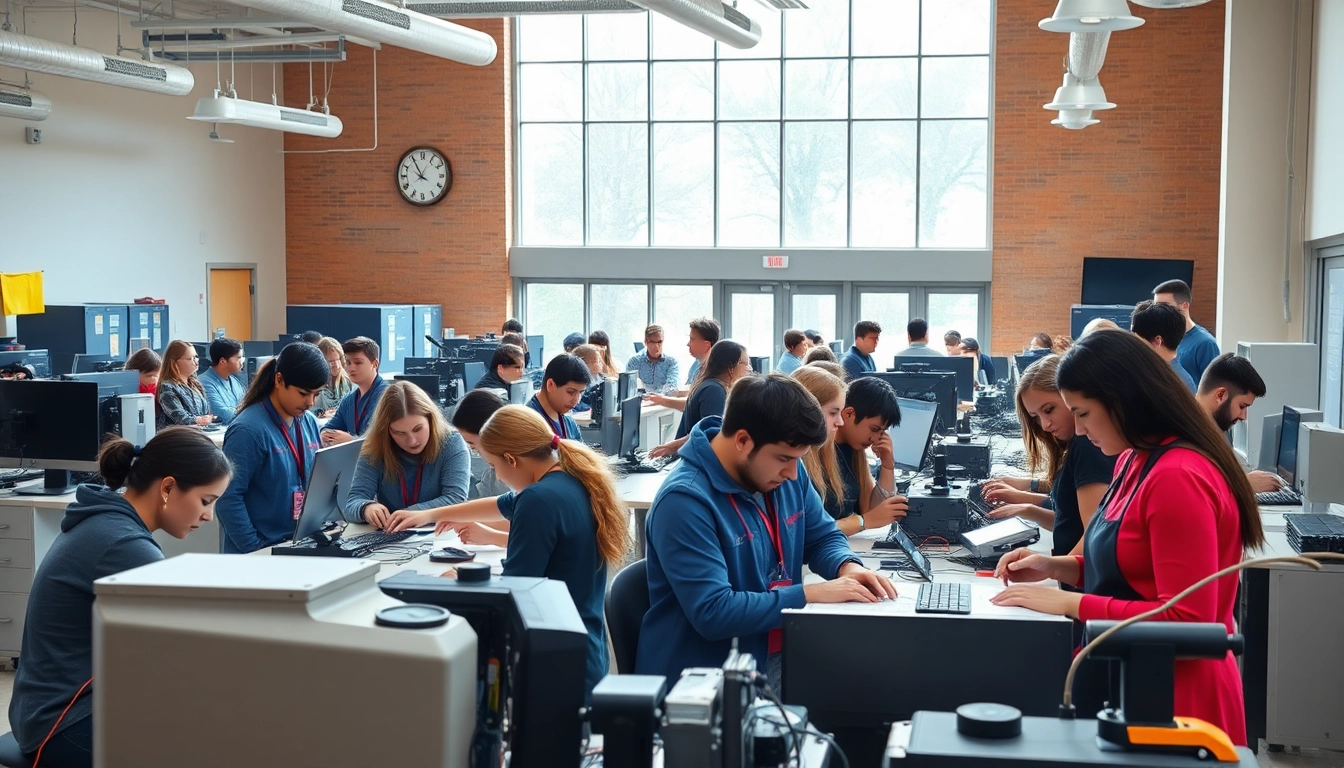Understanding the Role of Skilled Labor for Energy Sector
The energy sector has emerged as a cornerstone of modern economies, driving not only utility provision but also serving as a catalyst for job creation and technological advancement. At the heart of this industry lies a crucial component—skilled labor. As the demand for energy surges, fueled by population growth and technological advancements, ensuring a workforce equipped with the necessary skills becomes increasingly essential. The skilled labor for energy sector plays a pivotal role in maintaining operational efficiency, safety, and innovation within this dynamic field.
Key Responsibilities of Skilled Workers
Skilled workers in the energy sector are tasked with a variety of critical responsibilities that directly impact the operational success and efficiency of energy production and distribution. These professionals typically include welders, electricians, technicians, and engineers, each specializing in different aspects of energy systems.
The primary responsibilities of skilled workers include:
- Installation and Maintenance: Skilled laborers are responsible for installing new systems, maintaining existing infrastructure, and ensuring that all equipment operates efficiently.
- Monitoring and Repair: Continuous monitoring of systems for performance and safety is crucial. Skilled workers identify and rectify any operational failures to minimize downtime.
- Compliance and Safety Protocols: With stringent regulations governing the energy sector, these workers ensure that all operations comply with safety and environmental guidelines.
- Technical Problem-Solving: Skilled laborers utilize their expertise to troubleshoot technical issues, often requiring innovative solutions to complex problems.
Emerging Skill Set Requirements
The evolution of the energy sector, particularly with the rise of renewable sources like solar and wind, has led to new skill set requirements. Workers must now be adept not only in traditional energy generation techniques but also in advanced technologies.
Key emerging skills include:
- Renewable Energy Knowledge: Familiarity with solar panel installation, wind turbine maintenance, and energy storage systems is increasingly necessary.
- Data Analytics: As the energy sector becomes more digitized, workers need to harness data analytics to optimize operations and predict maintenance needs.
- Cybersecurity Awareness: With the increase in interconnected systems, knowledge of cybersecurity principles is crucial to protect infrastructures from malicious attacks.
- Interpersonal Skills: Collaboration and communication skills are vital, particularly as projects become more interdisciplinary.
Impact on Energy Production Efficiency
The contribution of skilled labor to energy production efficiency cannot be overstated. Their expertise leads to:
- Reduced Downtime: Skilled workers quickly address and resolve issues that can lead to system failures.
- Increased Output: Efficient installation and maintenance ultimately boost productivity, leading to higher energy output.
- Enhanced Safety: Knowledge of safety protocols reduces the risk of accidents, ensuring not only worker safety but also the reliability of energy supply.
- Improved Sustainability: Workers with up-to-date knowledge of renewable technologies contribute to transitioning towards greener energy solutions.
Current Challenges in Recruiting Skilled Labor for Energy Sector
Despite the essential role played by skilled workers, the energy sector faces significant challenges in recruitment and retention. Factors contributing to these obstacles include labor shortages, educational barriers, and the rapid pace of technological change.
Labor Shortages and Economic Factors
The energy sector is currently grappling with a notable labor shortage. Many experienced professionals are reaching retirement age, creating an urgent need for younger, skilled workers. However, this generation is often either unaware of the opportunities within the sector or lacks the requisite skills. According to industry data, the demand for skilled labor is projected to increase significantly in the coming years, exacerbating the challenges faced by employers who need to fill these critical positions.
Educational Barriers and Skills Gap
The skills gap is a significant barrier to recruiting qualified workers. Many educational programs fail to keep pace with the rapidly evolving technology in the energy sector. Vocational training and degree programs often do not provide students with hands-on experience in the latest technologies, leaving graduates unprepared for the workforce. Furthermore, the perception of energy sector jobs as less desirable due to their labor intensity and working conditions further deters potential entrants.
Adapting to Rapid Technological Changes
The technological landscape in the energy sector is constantly changing. Skilled workers must not only stay abreast of new technologies but must also be prepared to adapt to these changes almost continuously. This requires ongoing training and education, which can be a barrier for many workers. Employers also face the challenge of providing adequate training that is both time-efficient and relevant to their operations.
Strategies for Developing Skilled Labor for Energy Sector
To mitigate the challenges accompanying recruitment and ensure a pipeline of skilled labor, proactive strategies are essential. These may include forming partnerships with educational institutions, implementing structured training programs, and promoting certification paths.
Partnerships with Educational Institutions
Collaboration between energy companies and educational institutions is a crucial step towards producing a workforce equipped with the necessary skills. By working together, these entities can create programs that reflect current industry needs and trends.
Strategies may include:
- Curriculum Development: Industry professionals can contribute to educational curricula, ensuring that students learn relevant skills.
- Internships and Apprenticeships: Offering hands-on training opportunities provides students with practical experience and companies with potential future employees.
- Job Placement Programs: Institutions can facilitate connections between graduates and energy sector companies, easing entry into the workforce.
Implementation of Training Programs
In-house training programs can significantly enhance the skill levels of existing employees while ensuring that new recruits receive the necessary preparation for their roles. Effective training programs should be tailored to meet both the specific needs of the company and the evolving landscape of the energy sector.
Some key elements of successful training programs include:
- Hands-On Learning: Practical experience is vital. Training should incorporate real-world scenarios that employees are likely to encounter.
- Mentorship Systems: Pairing experienced workers with newer employees fosters knowledge transfer and skill development.
- Regular Updates: Continuous education is crucial to keep pace with technological advancements; training programs must adapt accordingly.
Promoting Micro-Credentials and Certifications
In today’s job market, micro-credentials and certifications can play a pivotal role in equipping workers with specific competencies needed in the energy sector. These qualifications often require shorter investment times compared to traditional degrees, making them appealing to potential workers.
Employers can actively promote these credentials by:
- Working with Certification Bodies: Collaborating with existing certification organizations to ensure programs meet industry standards.
- Covering Certification Costs: Offering financial assistance for employees seeking relevant certifications enhances workforce skill levels.
- Highlighting Career Advancement: Showcasing success stories of employees who have benefited from additional certifications can motivate others to pursue similar opportunities.
Best Practices for Retaining Skilled Labor for Energy Sector
Attracting skilled labor is only part of the equation; retaining this talent is equally, if not more, important. Companies must implement strategies to create a supportive environment that fosters long-term engagement and job satisfaction.
Creating a Positive Work Environment
A positive workplace culture is essential for employee retention. Skilled workers are more likely to remain with a company that values their input, prioritizes health and safety, and recognizes their contributions. Techniques to foster this include:
- Employee Recognition Programs: Regularly acknowledging accomplishments can boost morale and encourage loyalty.
- Encouraging Feedback: Creating avenues for open communication lets employees know their opinions are valued, leading to higher job satisfaction.
- Strong Leadership: Leaders who inspire and motivate employees create a more engaged workforce.
Offering Competitive Compensation Packages
While intrinsic motivations such as job satisfaction are crucial, competitive compensation remains a primary factor in retaining skilled workers. Fair wages, benefits, and retirement plans significantly affect employees’ decisions to stay with an organization. Additionally, employers must regularly reassess their compensation structures to ensure they remain competitive.
Cultivating Opportunities for Advancement
Employees are more likely to stay with a company that offers clear paths for advancement. Skilled laborers often seek ongoing personal and professional development opportunities. Employers can cultivate a culture of advancement by:
- Creating Career Pathways: Clear trajectories for advancement can motivate employees to develop their skills and commit to long-term employment.
- Providing Continuing Education: Supporting ongoing education and training ensures employees feel invested in their development.
- Regular Performance Reviews: Constructive feedback helps employees understand their growth areas and fosters a commitment to personal improvement.
Future Trends Impacting Skilled Labor for Energy Sector
The energy sector is on the precipice of significant transformation driven by technological advancements, the push for renewable energy, and the demand for sustainable practices. Understanding future trends is critical for stakeholders aiming to secure and develop a proficient workforce.
Growth of Renewable Energy and Job Creation
As the world shifts toward renewable energy sources, the demand for skilled labor is expected to rise significantly. The transition to solar, wind, and other green technologies will necessitate a profound change in the types of skilled roles available. This shift presents not only challenges but also vast opportunities for job creation.
Renewable energy jobs are often high-paying and present a chance for individuals to engage in meaningful work that benefits the environment—an attractive proposition for many job seekers.
Technological Advancements Shaping Job Roles
The integration of smart technology, big data, and the Internet of Things (IoT) in energy management is reshaping job roles and required skills. Technicians will need to be adept at managing increasingly complex systems, requiring continuous education and adaptability.
Employers who invest in their workforce’s technological training will lead the market by fostering skilled labor capable of navigating these technological advancements.
The Importance of Sustainable Practices
The growing emphasis on sustainability will continue to influence labor practices. Skilled workers are expected not only to execute responsibilities but also to innovate and integrate sustainable practices into their work. This requires a foundational understanding of environmental conservation and sustainable resource management, shaping the educational and training practices necessary for the future workforce.
In conclusion, the future of the energy sector significantly depends on addressing the needs surrounding skilled labor. With strategic investments in training, partnerships, and innovative practices, the sector can overcome current challenges, attract new talent, and ensure a capable workforce poised to meet tomorrow’s energy demands.


